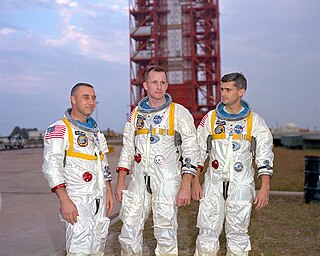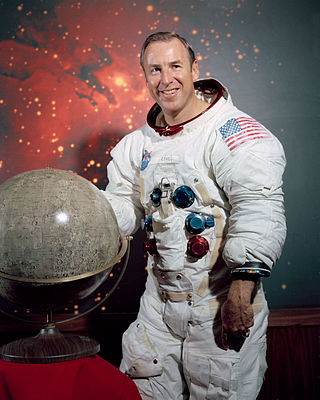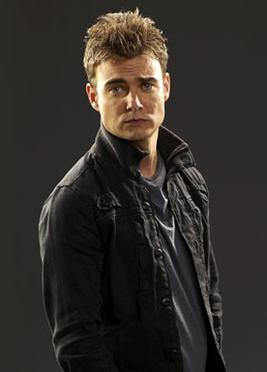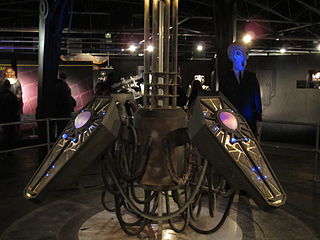Related Research Articles

Apollo 8 was the first crewed spacecraft to leave low Earth orbit and the first human spaceflight to reach the Moon. The crew orbited the Moon ten times without landing, and then departed safely back to Earth. These three astronauts—Frank Borman, James Lovell, and William Anders—were the first humans to witness and photograph the far side of the Moon and an Earthrise.

Apollo 1, initially designated AS-204, was planned to be the first crewed mission of the Apollo program, the American undertaking to land the first man on the Moon. It was planned to launch on February 21, 1967, as the first low Earth orbital test of the Apollo command and service module. The mission never flew; a cabin fire during a launch rehearsal test at Cape Kennedy Air Force Station Launch Complex 34 on January 27 killed all three crew members—Command Pilot Gus Grissom, Senior Pilot Ed White, and Pilot Roger B. Chaffee—and destroyed the command module (CM). The name Apollo 1, chosen by the crew, was made official by NASA in their honor after the fire.

Edward Higgins White II was an American aeronautical engineer, United States Air Force officer, test pilot, and NASA astronaut. He was a member of the crews of Gemini 4 and Apollo 1.

Frank Frederick Borman II is a retired United States Air Force (USAF) colonel, aeronautical engineer, NASA astronaut, test pilot, and businessman. He was the commander of Apollo 8, the first mission to fly around the Moon, and together with crewmates Jim Lovell and William Anders, became the first of 24 humans to do so, for which he was awarded the Congressional Space Medal of Honor. As of 2023, he is the oldest living former American astronaut, eleven days older than Lovell.

James Arthur Lovell Jr. is an American retired astronaut, naval aviator, test pilot and mechanical engineer. In 1968, as command module pilot of Apollo 8, he became, with Frank Borman and William Anders, one of the first three astronauts to fly to and orbit the Moon. He then commanded the Apollo 13 lunar mission in 1970 which, after a critical failure en route, circled the Moon and returned safely to Earth.

From the Earth to the Moon is a twelve-part 1998 HBO television miniseries co-produced by Ron Howard, Brian Grazer, Tom Hanks and Michael Bostick. In docudrama format, it tells the story of the Apollo program during the 1960s and early 1970s. Largely based on Andrew Chaikin's 1994 book, A Man on the Moon, the series is known for its accurate telling of the story of Apollo and the special effects under visual director Ernest D. Farino. The series takes its title from, but is not based upon, Jules Verne's 1865 science fiction novel From the Earth to the Moon.

NASA Astronaut Group 2, also known as the Next Nine and the New Nine, was the second group of astronauts selected by the National Aeronautics and Space Administration (NASA). Their selection was announced on September 17, 1962. The group augmented the Mercury Seven. President John F. Kennedy had announced Project Apollo, on May 25, 1961, with the ambitious goal of putting a man on the Moon by the end of the decade, and more astronauts were required to fly the two-man Gemini spacecraft and three-man Apollo spacecraft then under development. The Mercury Seven had been selected to accomplish the simpler task of orbital flight, but the new challenges of space rendezvous and lunar landing led to the selection of candidates with advanced engineering degrees as well as test pilot experience.

Magnificent Desolation: Walking on the Moon 3D is a 2005 IMAX 3D documentary film about the first humans on the Moon, the twelve astronauts in the Apollo program.

Space Race is a BBC docudrama series first shown in Britain on BBC2 between 14 September and 5 October 2005, chronicling the major events and characters in the American/Soviet space race up to the first landing of a man on the Moon. It focuses on Sergei Korolev, the Soviet chief rocket designer, and Wernher von Braun, his American counterpart. The series was a joint effort between British, German, American and Russian production teams.

Apollo 11 was the first human spaceflight to land on the Moon. The 1969 mission's wide effect on popular culture has resulted in numerous portrayals of Apollo 11 and its crew, Neil Armstrong, Buzz Aldrin, and Michael Collins.

Earthrise is a photograph of Earth and part of the Moon's surface that was taken from lunar orbit by astronaut William Anders on December 24, 1968, during the Apollo 8 mission. Nature photographer Galen Rowell described it as "the most influential environmental photograph ever taken".

Stargate Universe is a military science fiction drama television series and part of MGM's Stargate franchise. It follows the adventures of a present-day, multinational exploration team traveling on the Ancient spaceship Destiny several billion light years distant from the Milky Way Galaxy. They are now trying to figure out a way to return to Earth, while simultaneously trying to explore and to survive in their unknown area of the universe. The series, created by Brad Wright and Robert C. Cooper, premiered in the United States on Syfy on October 2, 2009. The series featured an ensemble cast and was primarily filmed in and around Vancouver, British Columbia, Canada. A second season of 20 episodes was announced by Syfy in December 2009.

The United States Astronaut Hall of Fame, located inside the Kennedy Space Center Visitor Complex Heroes & Legends building on Merritt Island, Florida, honors American astronauts and features the world's largest collection of their personal memorabilia, focusing on those astronauts who have been inducted into the Hall. Exhibits include Wally Schirra's Sigma 7 space capsule from the fifth crewed Mercury mission and the Gemini IX spacecraft flown by Gene Cernan and Thomas P. Stafford in 1966.

Dr. Helen Magnus is the protagonist and central character of the Canadian fantasy-science fiction television series Sanctuary. She is portrayed by Amanda Tapping. In the series, Magnus is a biologist from Victorian era England, who currently runs the global Sanctuary Network, an organization tasked with finding a series of creatures called "abnormals", and later bring them to a Sanctuary base for refuge to protect them from the human population. The character is over two and a half centuries old, having been given her advanced longevity by injecting herself with vampire blood, as well as reliving the 20th century from temporal displacement. After traveling back in time, Magnus had to avoid people, so she isolated herself. In the season 4 finale "Sanctuary For None: Part 2" It was revealed that Magnus spent the 113 years creating a new Sanctuary.

Dr. William "Will" Zimmerman is a main character and male lead of the Canadian fantasy-science fiction television series Sanctuary. He is portrayed by Robin Dunne. Will is introduced in the series as an FBI's Behavioral Analysis Unit forensic psychiatrist, who was recruited by Helen Magnus, head of the Sanctuary Network, to become her recent protégé.

Alice is a 2009 television miniseries that was originally broadcast on Canadian cable television channel Showcase and an hour later on American cable television channel Syfy. The miniseries is a reimagining of the classic Lewis Carroll novels Alice's Adventures in Wonderland (1865) and Through the Looking-Glass (1871), taking place about 150 years later with science fiction and additional fantasy elements added. The miniseries, produced by Reunion Pictures is three hours long, split into two parts, which premiered on Sunday, December 6, 2009, and Monday, December 7, 2009, respectively. Writer and director Nick Willing previously directed a 1999 adaptation of the books that followed the story more closely; however, Alice is intended to be a modern interpretation, imagining how Wonderland might have evolved over the last 143 years. The mini-series was partially shot in the Kamloops, British Columbia, Canada.

"Day of the Moon" is the second episode of the sixth series of the British science fiction television series Doctor Who. Written by show runner Steven Moffat, and directed by Toby Haynes, the episode was first broadcast on 30 April 2011 on BBC One in the United Kingdom and on BBC America in the United States. The episode is the second of a two-part story that began with "The Impossible Astronaut" on 23 April.

Pittsburgh Dad is an online series of short films featuring the observations of a "blue-collar" father from Pittsburgh who speaks with a thick Pittsburghese dialect. The series was created by Chris Preksta and Curt Wootton in 2011. Wootton plays the namesake character of Pittsburgh Dad in the series.
References
- ↑ Andrew Morton (19 July 2011). "Curt Wootton as Captain Jack Yaeger in The Mercury Men". The Morton Report.
- ↑ "'Mercury Men' Web series gets a shot on Syfy site". Pittsburgh Post-Gazette. 22 July 2011.